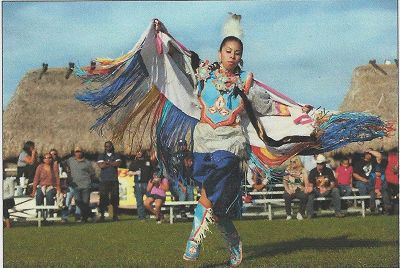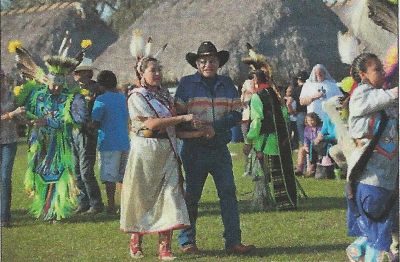 |
Canku Ota
|
 |
|
(Many Paths)
|
||
|
An Online Newsletter
Celebrating Native America
|
||
|
March 2015 - Volume
13 Number 3
|
||
|
|
||
|
Revelers Celebrate
Big Cypress Reservation’s 119th Anniversary
|
||
|
by Eileen Soler - Seminole
Tribune
|
||
Big Cypress, FL — Hundreds of cars and trucks packed a pasture-turned-parking lot Jan. 10 in Big Cypress where more than a century ago Seminole ancestors braved wilderness, swampland and bloody battles for Native American freedom. “The Seminole people were so tough to survive those times and then to come so far. We have to give the people a lot of credit,” said Fred Douglas, a self-described “cowboy from LaBelle,” at the Junior Cypress Rodeo Arena. About 1,600 people attended the Big Cypress 119th Anniversary Celebration, hosted by Councilman Mondo Tiger, that commemorated the Tribe’s victory against the U.S. Army, subsequent settlement in Big Cypress and ultimate formation of Big Cypress Reservation. According to public records, the Bureau of Indian Affairs in 1889 purchased 160 acres in Big Cypress in reserve for the Seminoles. In 1896, more land was added. Big Cypress Reservation was formally dedicated in 1936 and now consists of 82 square miles. Seminole and Miccosukee artists displayed and
sold handmade clothing, jewelry, baskets and wood carvings in The Tribal Historic Preservation Office exhibited a timeline of the Second Seminole War that spanned 1835 to the mid-1840s. The Third Seminole War began officially in 1855 in Southwest Florida and ended in 1858 with only a few hundred Seminoles in Big Cypress and other isolated areas of Florida. “Now the Tribe is 4,000 strong and growing,”
Councilman Tiger said. “For me, today means so much about what
my Tribal members and outsiders filled bleachers in the heart of the festival area to watch the Central Plains Dancers showcase Native American jingle, grass, shawl and eagle dances. Drummer Al Santos, a Taino/Arawak, kept the beat. Marty Thurman, a grass dancer from Shawnee, Oklahoma, told the audience that Native drumbeats are never the hard one-three beat heard in movies or at football games. “What you hear from real Native drums is the heartbeat of the Indian people – it is not written down; it is passed from generation to generation. If your heartbeat ever sounds like the Hollywood movie beat, please see a doctor right away,” Thurman said. Before the dancer’s finale, eagle dancer
Tony Wahweotten, of the Prairie Band Potawatomi Nation, led guests
in Wahweotten called performing at the anniversary
celebration “an honor.” “I’m happy to be a part
of it all and to Cowboy boots and hats blended with patchwork at the cultural event that capped off with a country concert. Western duo Montgomery Gentry took the stage first. Country rocker Gary Allan later brought down the house. Country fans Tim and Marianne Hamilton traveled
from Homestead to celebrate the Seminole anniversary and The couple said they admire Native history and culture. Once, on a motorcycle ride to Sturgis, South Dakota, they made a side trip to see the Crazy Horse Memorial. “We are both people who respect Native American people. It’s always nice to see culture that is so naturally spiritual,” Marianne Hamilton said. |
||||
|
|
||
|
|
||
| Canku Ota is a free Newsletter celebrating Native America, its traditions and accomplishments . We do not provide subscriber or visitor names to anyone. Some articles presented in Canku Ota may contain copyright material. We have received appropriate permissions for republishing any articles. Material appearing here is distributed without profit or monetary gain to those who have expressed an interest. This is in accordance with Title 17 U.S.C. Section 107. | ||
|
Canku Ota is a copyright ©
2000 - 2015 of Vicki Williams Barry and Paul Barry.
|
||
 |
 |
|
|
The "Canku
Ota - A Newsletter Celebrating Native America" web site and
its design is the
|
||
|
Copyright ©
1999 - 2015 of Paul C. Barry.
|
||
|
All Rights Reserved.
|
||

